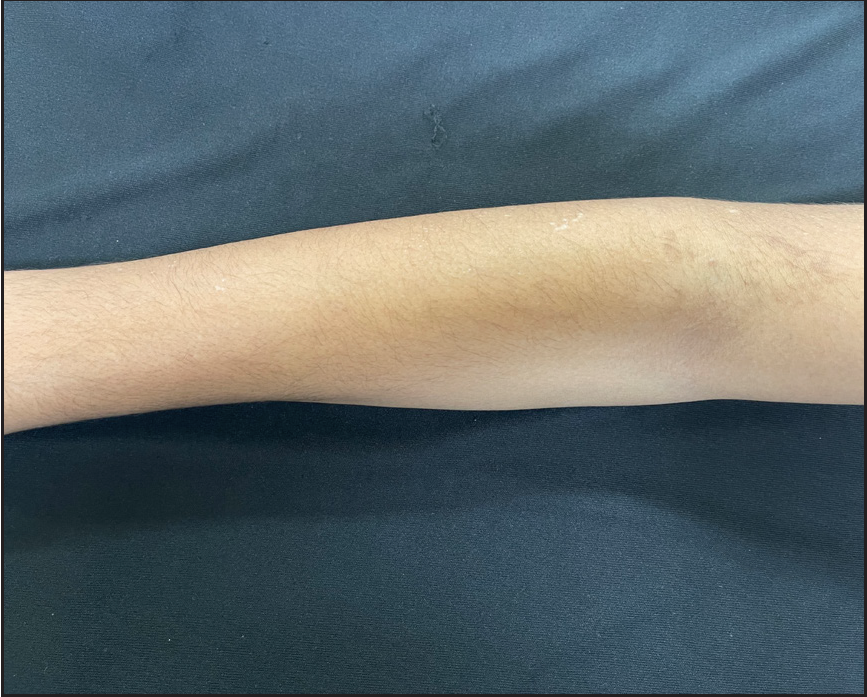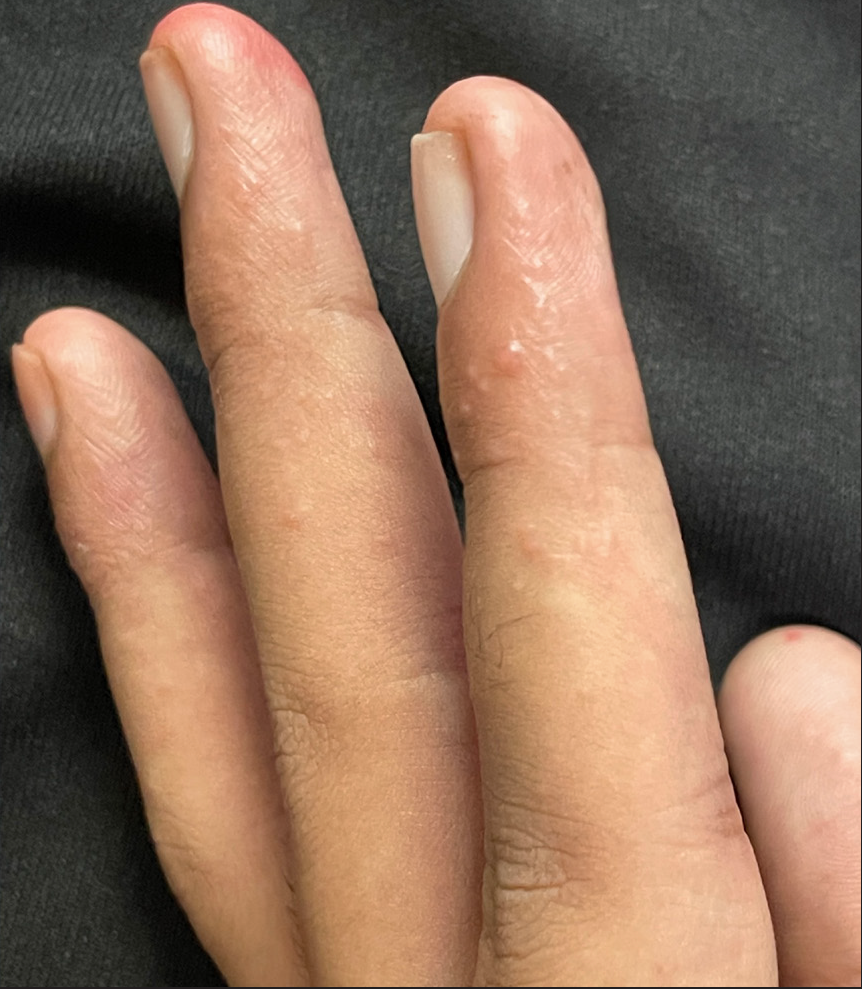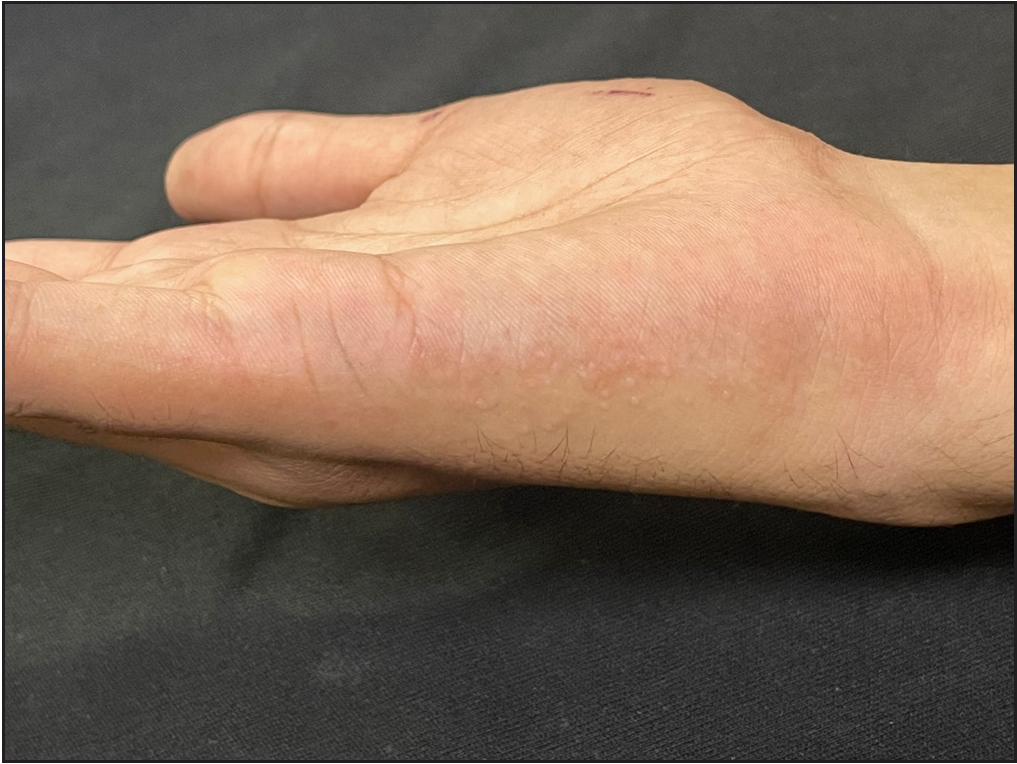Translate this page into:
A case of complex regional pain syndrome post herpes zoster; An underreported condition
Corresponding author: Dr. Preema Sinha, Department of Dermatology, Base Hospital, Lucknow, India. sinhapreema@gmail.com
-
Received: ,
Accepted: ,
How to cite this article: Sinha P, Sharma J, Kamboj P, GB P. A case of complex regional pain syndrome post herpes zoster; An underreported condition. Indian J Dermatol Venereol Leprol. 2024;90:794-6. doi: 10.25259/IJDVL_111_2023
Dear Editor,
CRPS (complex regional pain syndrome) was first reported in 1901 by Sudeck.1 It is a chronic condition typically affecting the extremities (hand and foot) and is characterised by persistent regional pain, disproportionate to the initial event. Complex regional pain syndrome is distinct from other chronic pain conditions due to the presence of signs indicating prominent autonomic and inflammatory changes in the region of pain, and is diagnosed with the help of Budapest criteria.2
Herpes zoster (HZ) infection is characterised by vesiculobullous lesions in a dermatomal distribution, caused by the reactivation of the varicella zoster virus (VZV). The reactivation of latent varicella zoster virus in the dorsal root ganglia results in herpes zoster (shingles), a localised cutaneous eruption that is accompanied by neuropathic pain.
A 20-year-old male presented with pain along the right upper limb. The patient had a history of herpes zoster involving the C5 dermatome one month ago [Figure 1]. He presented to us with pain along the right upper limb. Considering post-herpetic neuralgia as a diagnosis, he was started on gabapentin, tramadol and non-steroidal anti-inflammatory drug (NSAID) therapy but 1 month later, he presented with an increase in pain and multiple discrete shiny vesicles on the right hand associated with excessive sweating [Figures 2 and 3]. There was no history of trauma, seizures or muscle weakness.

- Scars of healed herpes zoster lesions over the right forearm involving the C5 dermatome

- Multiple discrete shiny vesicles on the fingers of the right hand associated with excessive sweating

- Multiple discrete shiny vesicles over the inner aspect of the right hand associated with excessive sweating
On physical examination, there was a deep burning pain (Numerical Rating Scale: 7/10), allodynia (tested by stroking cotton swab) and skin temperature changes with significant sweating leading to miliaria crystallina in the right hand and forearm, measured with a Vaporimeter (Delfin technologies Ltd.). The reading was 14 g/m2 H in the left hand while it was 24 g/m2 H in the right hand at the thenar eminence. The motor examination revealed no abnormalities in bilateral upper and lower limbs.
All haematological and biochemical investigations, including c-reactive protein and serum uric acid, were normal ruling out any inflammatory cause. A venous doppler and radiographs of both hands were found to be normal. Nerve conduction studies were normal.
The neurological examination of the patient included the presence or absence of complex regional pain syndrome-like symptoms as defined by the 2010 Budapest criteria along four categories: sensory, vasomotor, sudomotor/oedema and motor/trophic.2
The Budapest criteria were met [Table 1]2 and the diagnosis of complex regional pain syndrome post herpes zoster of the right upper limb was made in consultation with the neurologist. He was counselled about the condition and started on tab carbamazepine along with tab pregabalin 75 mg twice daily. He improved gradually over the next 1 month.
|
Complex regional pain syndrome of the hand with a limited extension does exist and it forms an important differential diagnosis, particularly in the case of localised and persistent pain post herpes infection. Approximate prevalence of localised complex regional pain syndrome affecting the hand is around 12%.
Several hypotheses can explain the mechanism of herpes zoster in causing complex regional pain syndrome. First mechanism can be attributed to the intense pain due to herpes zoster and this initial afferent nociceptive stimulus can sensitise multiple sympathetic neurons, resulting in sympathetic outflow. The second mechanism is secondary inflammation caused by herpes zoster infection induced cytopathic changes. The third mechanism is the development of abnormal synapses between efferent sympathetic nerves and afferent sensory nerves post herpes zoster infection.3
The significant accumulation of inflammation-related signs in our patient with only of 1 month duration, indicates an obvious inflammatory component during the early phase of the complex regional pain syndrome, which is consistent with the finding reported by Ott et al.4
Complex regional pain syndrome is to be suspected in patients of herpes zoster when there is no relief or an increase in symptoms, in spite of early pharmacological intervention and also when there is pain with trophic, sensory and motor changes [Table 2]. We report this case to draw attention to the existence of complex regional pain syndrome after herpes zoster infection, which is rarely reported in literature, as generally cases with similar presentations are misdiagnosed and managed as post-herpetic neuralgia.
| Complex regional pain syndrome | Post-herpetic neuralgia | |
|---|---|---|
| Clinical |
Complex regional pain syndrome causes include neuromas, ganglia and nerve entrapments |
Persistent pain within a dermatome and affects the region which is innervated by the dermatome PHN causes include varicella zoster virus infection |
| Diagnostic |
History Physical examination Budapest criteria |
History Clinical examination |
| Management |
Pharmacologic therapy: Corticosteroids, antidepressants, opioids, ketamine Interventional treatment: Sympathetic nerve block, spinal cord stimulation Other treatments include vocational, psychological and occupational therapy |
Pharmacologic therapy: Acetaminophen, non-steroidal anti-inflammatory agents and opioids Interventional treatment: Sympathetic blocks, intrathecal injections or surgical interventions and zoster vaccine |
| Prognosis | Good | Good |
Declaration of patient consent
The authors certify that they have obtained all appropriate patient consent.
Financial support and sponsorship
Nil.
Conflict of interest
There is no conflict of interest.
Use of artificial intelligence (AI)-assisted technology for manuscript preparation
The authors confirm that there was no use of artificial intelligence (AI)-assisted technology for assisting in the writing or editing of the manuscript and no images were manipulated using AI.
References
- Going toe-to-toe with a rare case of a complex regional pain syndrome limited to the hallux. BMJ Case Reports CP. 2021;14:e242781.
- [Google Scholar]
- Validation of proposed diagnostic criteria (the “Budapest Criteria”) for complex regional pain syndrome. Pain. 2010;150:268-74.
- [CrossRef] [PubMed] [Google Scholar]
- A hypothesis on the physiological basis for causalgia and related pains. Pain. 1986;24:297-311.
- [CrossRef] [PubMed] [Google Scholar]
- Signs and symptoms in 1,043 patients with complex regional pain syndrome. J Pain. 2018;19:599-611.
- [CrossRef] [PubMed] [Google Scholar]





